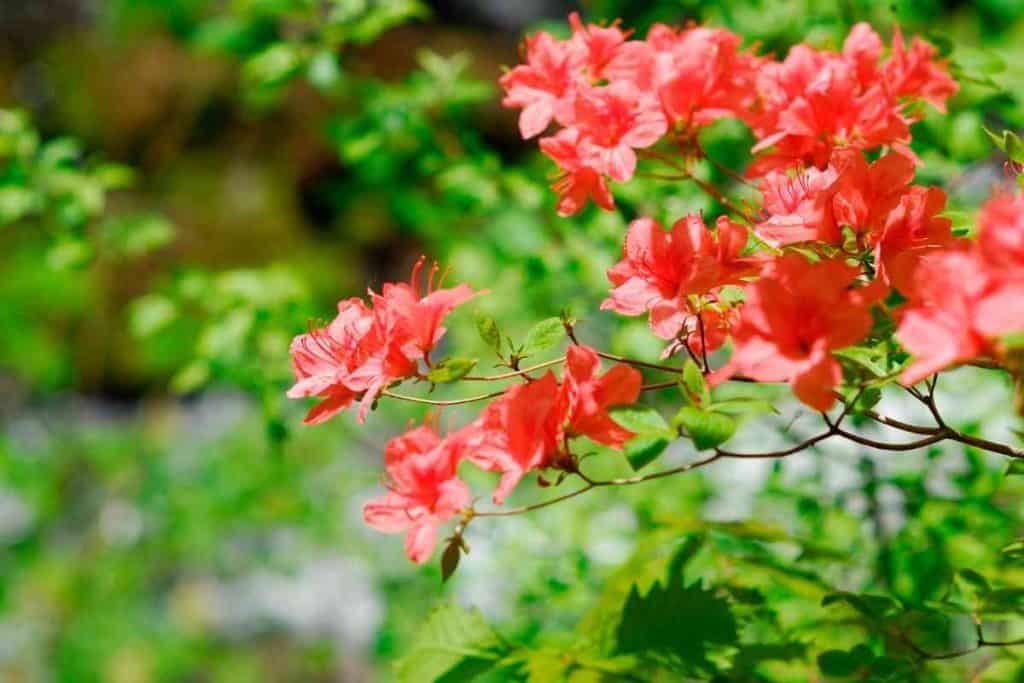Azalea is a trending flowering plant featuring bright spring flowers. It has its origins in the Asian, Europe, and North American regions and comes from the Rhododendron family, which shares similar traits. The azalea sheds its leaves during the fall. But what are the causes of azalea leaves turning yellow?
Azalea leaves turn yellow because of several occurrences like; lack of nitrogen in the soil, excessive alkaline in the soil, insufficient watering, and inadequate soil drainage.
In this article, we will be looking at the various reasons why your azalea leaves are turning yellow and what you can do to stop and prevent this from happening.
Let's get started!
Table of Contents
What Is Azalea Plant?
Azalea is a specie under the Rhododendron family of Ericaceae, although it initially came from the genus Azalea hybrid. It is native to the Asian, Europe, and North American regions. Most Azealas are planted as ornamental plants for beautification because of their attractive flowers.
Again, many of its grown types have been bred from species from the hilly Asian and North American areas. While most azalea varieties are deciduous, the rest of the rhododendron family are evergreen. Azalea features funnel-shaped flowers that are double-lipped and with good smell.
Some other rhododendrons feature bell-shaped flowers. Azalea flowers significantly feature just five projecting stamens, unlike different varieties of rhododendrons that have ten or more stamens. There are, however, few intermediate forms that produce neither five nor ten stamens.
Azalea Leaves Turning Yellow (Causes and Remedies)

Azalea consists of a different group of woody plants under the rhododendron species that produce flowers during the spring and are hardy in zones 4-9 of the U.S. Department of Agriculture. If your azalea leaves turn yellow, this situation is what is called Chlorosis.
Chlorosis is a significant problem that shows that the azalea is finding it hard to absorb essential nutrients. Therefore, Chlorosis is a sign of an underlying problem.
That said, below are the possible causes and solutions to azalea leaves turning yellow?
1. Lack of Nitrogen in the Soil
One of the most significant reasons for azalea leaves turning yellow is an insufficient level or lack of nitrogen in the soil. It can result from nutrient-poor soils like sandy soils or mulching around the azalea soil.
On the other hand, adding mulch is not a bad idea, as it is made up of organic materials, which help keep a proper moisture balance around the azalea roots and give additional nutrients. However, it would be best to wait for the organic material to properly decompose before adding it to the soil around the plant.
Meanwhile, the organic matter needs nitrogen to be a part of its decomposition process, which it receives from the soil; thus, producing a temporary addition of nitrogen in the ground when the mulch is decomposing around your plant. With time, the nitrogen goes back into the soil during the incorporation process of the mulch into the soil.
However, the short-term deposition, which is due to the mulch decomposition, implies that your azalea roots failed to receive sufficient nitrogen in the soil. Therefore, the stress it undergoes and insufficient nutrients cause the azalea's leaves to turn yellow, thus showing nitrogen to be an essential nutrient for the plant.
How Can It Be Solved?
You can address the problem of insufficient soil nutrients of the azalea in just two ways:
- Apply a nitrogen-based fertilizer into the soil to solve the temporary nitrogen insufficiency
- Get rid of the decomposing mulch and add a properly-rotted material
2. Alkaline Soil pH
Every azalea species requires acidic soils, as they depend on them for iron. Using alkaline soil for an azalea plant will cause its leaves to become yellow. In other words, alkaline soils are not ideal for azaleas and rhododendron plants.
The best soil pH for these plants is between pH 4-and 6, with pH 5.5 the most suitable. Note that pH 7 is neutral, and anything above pH 7 is considered alkaline. Therefore, if your azalea develops yellow leaves, it is stressed due to alkaline soils instead of acidic.
Whenever an azalea or rhododendron is suffering from yellowing of leaves, it means it is suffering from iron deficiency due to the lack of acidic soil pH. Below are the possible solutions to these problems:
How Can this Be Solved?
- First, you must check the amount of the pH of your soil—sort for possible causes by observing which other plants do well in that part. Plants like Roses, Rhododendrons, other Azaleas, daffodils, and camellias thrive in acidic soils.
- If the plants mentioned above do well in your garden or your neighbor's garden, it shows that alkaline soils do not cause the yellowing of leaves.
- In a case where you are still confused about what the problem is, then we urge you to buy a soil gauge that measures the pH of your soil.
- Test the soil in many areas of your garden to be sure since there could be a notable difference in the soil pH in a small space. Especially if the cause of alkaline soil is artificial (like builders' rubble under the garden or wood ash spread around as the two can be very alkaline).
- It is effortless to use soil gauges, as they will afford you a trustworthy reading of the soil pH, and above all, you can get them at very affordable rates on amazon. Knowing your soil's pH is very important, as it will help you purchase the specific plants that are perfect for your garden, thereby saving you much cost, time, and effort.
- Assuming your soil is genuinely alkaline, then the possible solution to the soil is the application of garden lime which you can always find in all good garden stores. If you want to change the pH of the soil, it requires a slow and steady process and is not long-term since the soil will probably come back to its initial alkalinity in the long run.
3. Insufficient Water in the Azalea

Another possible cause of azalea leaves turning yellow is that your plant is stressed because it is not receiving sufficient water. Azalea is not one of those drought-resistant plants out there and, therefore, needs its soil to be moist with frequent watering to help keep it strong and healthy.
If you discover that the soil around your plant is dry to the finger's depth, it means that the cause of the yellow leaves is due to lack of water. So, azaleas require moist but well-draining soil with high organic content.
Therefore, the possible cause of your azalea drought could be low rainfall or insufficient watering or the fast drainage of the soil such that it fails to retain moisture.
How Can It Be Solved?
- During dry seasons, make sure you water the azalea at least three times a week, as it will help to prevent drought.
- Make sure you grow your azalea in soil with sufficient organic material like garden compost, leaf mold, or properly-rotted manure. These materials help preserve some needed amount of water and provide nutrients.
- You can apply at least a 1-inch layer of organic mulch, as it helps to retain moisture in the hot growing period. The ideal soil is properly-rotted compost that has decayed for one year. It helps to minimize evaporation, keep the roots tremendous during the summer, and adds to the moist soil situations that azaleas require to do well.
4. Slow Draining Soils
If your azalea is experiencing yellow leaves, it could also be caused by root rot, otherwise called Phytophthora, resulting from a slow-draining soil. Even though azaleas need water-retentive soils, they also require the soil to drain excess water to prevent the roots from sitting in water-clogged grounds.
You can achieve this by addressing the soil using a large amount of organic matter like good compost before you plant and adding one layer of mulch during the spring.
How Can It Be Solved?
- If you want to prevent your clay soil from becoming slick in the wet and sticking to your shovel and boots, thereby stressing you or testing your patience, you must work your clay soil in dry weather.
- Avoid applying sand to clay soil because it improves drainage instead used gravel. Sand and clay can form a cement such as texture that is ridiculously difficult to tolerate.
- Gravel is a better option, and it will increase the size of the pores in the soil and will not result in similar complicated textures.
- Again, apply significant amounts of compost to the hole before replanting because compost is well-draining and keeps the soil in perfect shape.
- Applying mulch around the plant all year round during the spring will also help to increase the infiltration rate of clay soil and slowly improve the soil in the long run.
- Some gardeners can benefit significantly from using clay soils since they are suitable for effectively retaining nutrients. However, clay soils without other notable contributions from different materials will drain very slowly for several plants.
- Loam soils (containing around 20% clay) are seen as ideal for planting azaleas with notable amounts of organic matter or silt (about 40%) and sand or gravel (40%). These compositions will help provide high nutrients and preserve some moisture while allowing proper drainage.
You can also read:
- Do Haworthia Die After Flowering? (Explained)
- Why Is My Cactus Turning Brown? (How To Save It)
- Why Are My Lilac Bushes Turning Brown? (How To Revive It)




